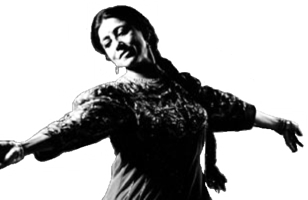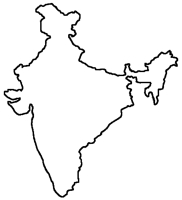
|
The Society of Folk Dance Historians (SFDH)
Folk Dance of India
[
Home |
About |
Encyclopedia | CLICK AN IMAGE TO ENLARGE |

|
 The drumbeat gets louder and louder, drawing people from all sides. Everyone rushes to the open space in the center of the village. They clap to keep time and sing. Very soon, there is a swaying mass, ready to break into a dance.
The drumbeat gets louder and louder, drawing people from all sides. Everyone rushes to the open space in the center of the village. They clap to keep time and sing. Very soon, there is a swaying mass, ready to break into a dance.
This scene could have taken place anywhere in India – from the snow-capped Himalayas to the near-equatorial jungles of Cape Comerin, or from arid Rajasthan where the warriors whirl in wild splendor, to the lush valleys of Manipur, where men and women dance the more intricate rhythms in their own inimitable style.
Folk dances originated in ancient India at a time when it was thought that the nature gods could be appeased or invoked through magical chants and dances. Even though the land was rich and fertile, the peasants had to depend upon the erratic monsoon rains. They danced, therefore, to show their thankfulness for a bountiful harvest and also to entreat the deities for mercy in times of droughts and floods.
Dance rhythms have evolved naturally from everyday chores like sweeping the house, milking the cows, pounding the rice, or from the fields as scattering the seed, cutting the harvest, etc. They came also from the birds and animals an even from the swaying of the plants in a gentle breeze.
Although these themes and rhythms are common to all India, the vast geographical differences have given each region a uniqueness that is at once apparent in its music, rhythm, poetry, costume, and style. Folk dances in India may be classified into three groups:
- Tribal dances – mainly ritualistic,
- Folk dances performed by hereditary professional families – mainly stylized for entertainment.
- Community dances – social and ceremonial,
1. TRIBAL DANCES
Aboriginal tribes still inhabit many parts of India. Dance is intricately entwined with every aspect of their lives, and on the proper execution of the dance depends the success of any adventure. Undoubtedly this belief in the absolute power of the dance is gradually changing as the tribes come into contact with the outside world.
A dance-lover's heaven is the State of Orissa where there are several tribes all noted for their beautiful dances. The Murias for instance, assign the task of dance performance to the unmarried boys and girls. The young people meet each evening in the community center (rather like a Youth Center) and practice singing and dancing. The dances are an essential part of most ceremonies such as weddings, funerals, and spring festivals. It is not unusual to find Muria ensembles of over one hundred dancers doing the most intricate dance patterns in complete unison – a truly breathtaking sight!
Of course in some regions even the young people are busy helping the parents eke out a meagre existence. Thus we find, that to the Savaras, a hill tribe of Orissa, dance is a serious business. The dance is an essential part of a ritual. The Savaras are unique in that they have no circle dances. Indeed, their villages are so tiny and carved into the hillsides, that there would not be enough room to form even a small circle. Most of their dances look like processionals because they are danced to escort someone or something from one place to another, that is, a bride to her new home, or the remains of someone who died outside the village.
Of course, many unique tribal dances can be found all over India – the mimetic Buffalo Dance of the Gouds and the dances on stilts of the swampy regions.
2. HERIDITARY FOLK DANCES
These are performed by hereditary troupes more as a form of entertainment. These troupes travel the countryside and perform at births, weddings, etc. All of their dances are stylized in the folk style as opposed to the classical and use of the folk idiom. They frequently use masks and elaborate costumes, that is, the Gambhira of Bengal, the Chou from Siraikella, the Valakkalti of Kerals, and many others.
3. COMMUNITY FOLK DANCES
Perhaps best known dances that the everyday person comes across would be the community dances of his region. Each area has its own dances, but some are better known than others. It is not possible to touch on all of them in this article, so a few are chosen at random.
 Bhangra – This is a harvest dance performed with great vigor by the farmers of the Punjab. The dance is punctuated by song. As the dance proceeds, more and more men join in. It is noted for its vigor and spontaneous hilarity. The dancers clap and exclaim joyously.
Bhangra – This is a harvest dance performed with great vigor by the farmers of the Punjab. The dance is punctuated by song. As the dance proceeds, more and more men join in. It is noted for its vigor and spontaneous hilarity. The dancers clap and exclaim joyously.
Gidha – The women of the Punjab dance this dance, a circular dance, clapping out the rhythm.
Ghumer – From Rajasthan, the land of the chivalrous Rajputs, come dances like the "Ghumer," a word meaning "going around," in which the dancers whirl around and around. It is danced mainly by the women, although occasionally the men join in.
Ras – This is a popular dance and its many varieties are danced all over India. When it is done with sticks, it is called Dandiya Ras. The dancers strike two sticks together to the beat of the rhythm as they move in a circle.
The dances of the Kohu fishermen recreate the roaring waves of the Arabian Sea, while the Naga dances depict all aspects of life in the jungle. The dances of the Banjara Romani of Andhra are very simple and are danced to a special drum.
These are just a few examples of dances that represent the culture of this people of India, portraying their joys and their hopes.
"The dancing foot – the tinkling bells,
The songs that are sung and the varying steps.
Find these within yourself,
Then shall your fetters fall away. . . .
(Translated from an old Indian folk song)
DOCUMENTS
- Dance in India, an article.
- India, a country.
Originally appeared in the December 1973 issue of the Ontario Folkdancer.
Printed in Folk Dance Scene, April 1982.
This page © 2018 by Ron Houston.
Please do not copy any part of this page without including this copyright notice.
Please do not copy small portions out of context.
Please do not copy large portions without permission from Ron Houston.